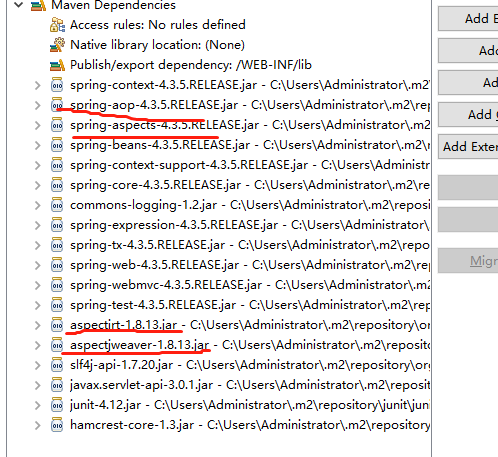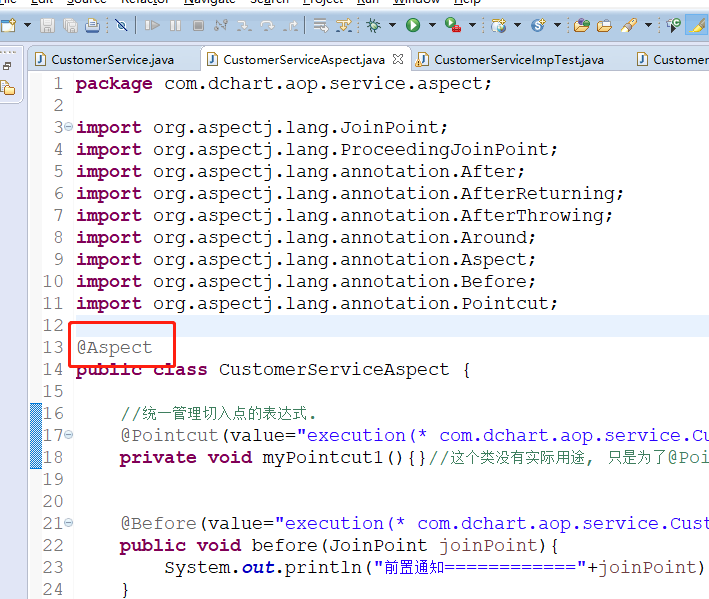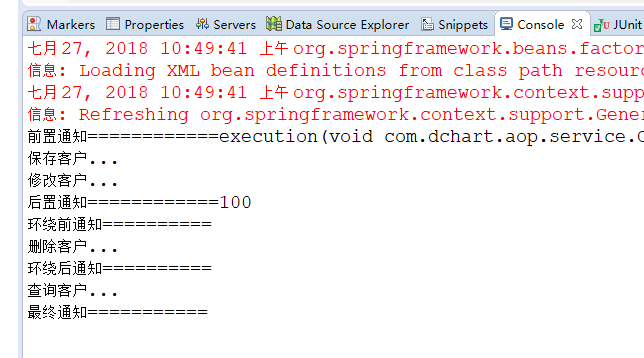源码:https://gitee.com/kszsa/dchart
一, AspectJ的概述:
AspectJ是一个面向切面的框架,它扩展了Java语言。AspectJ定义了AOP语法所以它有一个专门的编译器用来生成遵守Java字节编码规范的Class文件。
Spring为了简化自身的AOP的开发,将AspectJ拿过来作为Spring自身一个AOP的开发.
二, Spring AspectJ开发实例
2.1 开发所需jar包

maven中相关包引入
<dependency> <groupId>org.springframework</groupId> <artifactId>spring-aop</artifactId> <version>${spring.version}</version> </dependency> <dependency> <groupId>org.springframework</groupId> <artifactId>spring-aspects</artifactId> <version>${spring.version}</version> </dependency> <!-- aspectJ依赖包 --> <dependency> <groupId>org.aspectj</groupId> <artifactId>aspectjrt</artifactId> <version>${aspectj.version}</version> </dependency> <dependency> <groupId>org.aspectj</groupId> <artifactId>aspectjweaver</artifactId> <version>${aspectj.version}</version> </dependency>
2.2 AspectJ 注解开发规范
2.2.1 AspectJ的切入点:
//统一管理切入点的表达式.
@Pointcut(value="execution(* com.dchart.aop.service.CustomerService+.find(..))")
private void myPointcut1(){}//这个类没有实际用途, 只是为了@Pointcut 注解
2.2.2 @AspectJ提供不同的通知类型
@Before 前置通知,相当于BeforeAdvice
在执行目标方法之前完成一个操作,获得到切入点信息.
@Before(value="execution(* com.dchart.aop.service.CustomerService+.save(..))")
public void before(JoinPoint joinPoint){
System.out.println("前置通知============"+joinPoint);
}
@AfterReturning 后置通知,相当于AfterReturningAdvice
在目标方法执行之后完成一个操作,获得方法的返回值.
@AfterReturning(value="execution(* com.dchart.aop.service.CustomerService+.update(..))",returning="result")
public void afterReturn(Object result){
System.out.println("后置通知============"+result);
}
@Around 环绕通知,相当于MethodInterceptor
在目标方法执行的前和执行后完成一个操作,阻止目标方法执行.
@Around(value="execution(* com.dchart.aop.service.CustomerService+.delete(..))")
public Object around(ProceedingJoinPoint joinPoint) throws Throwable{
System.out.println("环绕前通知==========");
Object obj = joinPoint.proceed();
System.out.println("环绕后通知==========");
return obj;
}
@AfterThrowing抛出通知,相当于ThrowAdvice
在目标方法出现异常的时候,完成一个操作.获得异常信息.
@AfterThrowing(value="CustomerServiceAspect.myPointcut1()",throwing="e")
public void afterThrowing(Throwable e){
System.out.println("异常抛出通知========="+e.getMessage());
}
@After 最终final通知,不管是否异常,该通知都会执行
在目标方法任何情况下都会执行的操作.相当于finally中的代码.
@After(value="CustomerServiceAspect.myPointcut1()")
public void after(){
System.out.println("最终通知===========");
}
2.2.3 通过配置启用@AspectJ切面
1、开启AspectJ的自动代理
<?xml version="1.0" encoding="UTF-8"?> <beans xmlns="http://www.springframework.org/schema/beans" xmlns:xsi="http://www.w3.org/2001/XMLSchema-instance" xmlns:aop="http://www.springframework.org/schema/aop" xmlns:context="http://www.springframework.org/schema/context" xsi:schemaLocation="http://www.springframework.org/schema/beans http://www.springframework.org/schema/beans/spring-beans.xsd http://www.springframework.org/schema/aop http://www.springframework.org/schema/aop/spring-aop-4.0.xsd http://www.springframework.org/schema/context http://www.springframework.org/schema/context/spring-context-4.0.xsd"> <!-- 开启AspectJ自动代理 --> <aop:aspectj-autoproxy></aop:aspectj-autoproxy> </beans>
2、对应的切面类添加注解

2.2.4 Aspect和Advisor的区别:
Advisor :传统的切面.传统切面一般都是由一个切入点和一个通知的组合.
Aspect :真正意义上的切面.由多个切入点和多个通知的组合.
2.2.5 在通知中通过value属性定义切点
通过execution函数,可以定义切点的方法切入
语法:
execution(<访问修饰符>?<返回类型><方法名>(<参数>)<异常>)
例如
匹配所有类public方法 execution(public * *(..))
匹配指定包下所有类方法 execution(* cn.itcast.dao.*(..)) 不包含子包
execution(* cn.itcast.dao..*(..)) ..*表示包、子孙包下所有类
匹配指定类所有方法 execution(* cn.itcast.service.UserService.*(..))
匹配实现特定接口所有类方法 execution(* cn.itcast.dao.GenericDAO+.*(..))
匹配所有save开头的方法 execution(* save*(..))
2.3 Spring AspctJ 基于注解模式的开发例子
定义接口CustomerService.java
package com.dchart.aop.service; public interface CustomerService { public void save(); public Integer update(); public void delete(); public void find(); }
接口实现
CustomerServiceImp.java
package com.dchart.aop.service.imp; import com.dchart.aop.service.CustomerService; public class CustomerServiceImp implements CustomerService { @Override public void save() { System.out.println("保存客户..."); } @Override public Integer update() { System.out.println("修改客户..."); return 100; } @Override public void delete() { System.out.println("删除客户..."); } @Override public void find() { System.out.println("查询客户..."); // int d = 1 / 0; } }
编写切面类
CustomerServiceAspect.java
package com.dchart.aop.service.aspect; import org.aspectj.lang.JoinPoint; import org.aspectj.lang.ProceedingJoinPoint; import org.aspectj.lang.annotation.After; import org.aspectj.lang.annotation.AfterReturning; import org.aspectj.lang.annotation.AfterThrowing; import org.aspectj.lang.annotation.Around; import org.aspectj.lang.annotation.Aspect; import org.aspectj.lang.annotation.Before; import org.aspectj.lang.annotation.Pointcut; @Aspect public class CustomerServiceAspect { //统一管理切入点的表达式. @Pointcut(value="execution(* com.dchart.aop.service.CustomerService+.find(..))") private void myPointcut1(){}//这个类没有实际用途, 只是为了@Pointcut 注解 @Before(value="execution(* com.dchart.aop.service.CustomerService+.save(..))") public void before(JoinPoint joinPoint){ System.out.println("前置通知============"+joinPoint); } @AfterReturning(value="execution(* com.dchart.aop.service.CustomerService+.update(..))",returning="result") public void afterReturn(Object result){ System.out.println("后置通知============"+result); } @Around(value="execution(* com.dchart.aop.service.CustomerService+.delete(..))") public Object around(ProceedingJoinPoint joinPoint) throws Throwable{ System.out.println("环绕前通知=========="); Object obj = joinPoint.proceed(); System.out.println("环绕后通知=========="); return obj; } @AfterThrowing(value="CustomerServiceAspect.myPointcut1()",throwing="e") public void afterThrowing(Throwable e){ System.out.println("异常抛出通知========="+e.getMessage()); } @After(value="CustomerServiceAspect.myPointcut1()") public void after(){ System.out.println("最终通知==========="); } }
单元测试类CustomerServiceImpTest.java
package com.dchart.aop.service.imp; import static org.junit.Assert.*; import javax.annotation.Resource; import org.junit.Test; import org.junit.runner.RunWith; import org.springframework.test.context.ContextConfiguration; import org.springframework.test.context.junit4.SpringJUnit4ClassRunner; import com.dchart.aop.service.CustomerService; @RunWith(SpringJUnit4ClassRunner.class) @ContextConfiguration("classpath:spring_aop.xml") public class CustomerServiceImpTest { @Resource(name="customerService") private CustomerService customerService; @Test public void test() { customerService.save(); customerService.update(); customerService.delete(); customerService.find(); } }
Spring 配置文件:spring_aop.xml
<?xml version="1.0" encoding="UTF-8"?> <beans xmlns="http://www.springframework.org/schema/beans" xmlns:xsi="http://www.w3.org/2001/XMLSchema-instance" xmlns:aop="http://www.springframework.org/schema/aop" xmlns:context="http://www.springframework.org/schema/context" xsi:schemaLocation="http://www.springframework.org/schema/beans http://www.springframework.org/schema/beans/spring-beans.xsd http://www.springframework.org/schema/aop http://www.springframework.org/schema/aop/spring-aop-4.0.xsd http://www.springframework.org/schema/context http://www.springframework.org/schema/context/spring-context-4.0.xsd"> <!-- 开启AspectJ自动代理 --> <aop:aspectj-autoproxy></aop:aspectj-autoproxy> <!-- 目标对象 --> <bean id="customerService" class="com.dchart.aop.service.imp.CustomerServiceImp" /> <!-- 配置切面 --> <bean id="myAspectAnno" class="com.dchart.aop.service.aspect.CustomerServiceAspect" /> </beans>
运行结果:

源码:https://gitee.com/kszsa/dchart
参考地址:http://www.cnblogs.com/wang-meng/p/5641687.html